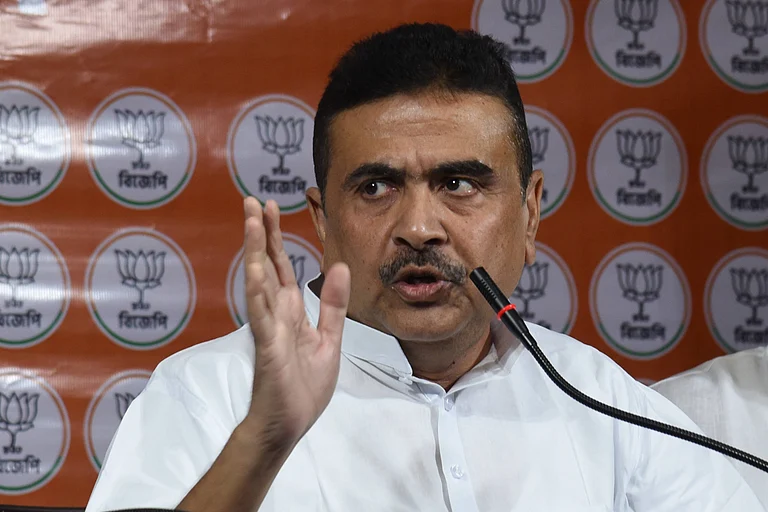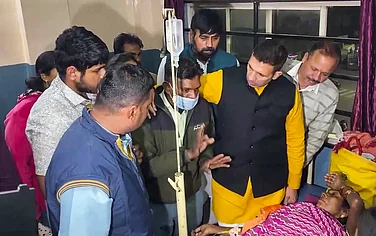On the outskirts of a tea garden in Takdah of West Bengal’s Darjeeling district, Bimal Subba sips his first flush―without milk and sugar―at his small, roadside hardware shop, looking bored. A few political workers are distributing leaflets in the vicinity. The middle-aged man shows no interest.
On a clear day, the mighty Kangchenjunga glitters on the other side of the road. But it is one of those dark and depressing weeks when people yearn for a ray of sunlight. Dense fog and clouds have wrapped every hill and mountain peak, hiding one from the other due to the absence of visibility.
Subba sounds depressed. “Gorkhaland is the hearts of every Gorkhali-speaking people. The BJP has fooled us for 15 years promising to take us closer to Gorkhaland. It’s nowhere closer than what it was before Narendra Modi became the prime minister. But what alternative do we have? The State will never concede to our demand.”
Gorkhali is another name for the Nepali language, spoken by the people of Nepali ethnic groups, who live in Nepal and parts of Nepal-bordering northern and eastern India, predominantly in the Darjeeling hills, comprising Darjeeling, Kurseong and Kalimpong hill stations, and Sikkim.
Historically, the words Gorkha and Nepali have been used interchangeably to refer to the same ethnic group. The language is one of India’s official languages, listed as Nepali. But in Darjeeling, people of Nepali ethnic groups prefer to call themselves Gorkha and their language Gorkhali.
“One of the pitfalls of having people of the same ethnic group on the other side of the border, with a country of their own, is that Darjeeling’s Nepali-speaking people are often suspected as Nepali nationals in different parts of India,” says Prakash Lama, a small trader in Tinchuley village, Darjeeling.
“That’s one of the reasons we want Gorkhaland, an Indian homeland for us,” Lama says, as he takes a break from serving tourists at his small eatery.
There is no dearth of issues that the likes of Subba and Lama like to highlight―from insufficient electricity coverage and water scarcity to poor roadways and unstable mobile networks; lack of medical facilities and job opportunities. Along the Teesta River, erosion and flood damage victims complain of neglect by both parties.
But to many, the solution to all these administrative deficiencies lies in getting a state of their own―when the hills are governed from Darjeeling, and not Kolkata.
Of West Bengal’s major political parties, Chief Minister Mamata Banerjee’s Trinamool Congress (TMC), the CPI(M) and the Congress are strongly opposed to any division of the state.
Modi’s Bharatiya Janata Party (BJP) has won Darjeeling three times on a trot, trouncing the Congress in 2009 and the TMC in 2014 and 2019, by announcing its sympathies for the struggle of Darjeeling’s Gorkhas. But they have not kept their promises.
At present, both the TMC and the BJP enjoy the backing of a section of Gorkha political leadership.
While the TMC hopes to gain from the division in Gorkha’s political leadership, the big question that remains to be answered is whether the Gorkha leaders aligning with the TMC have managed to effect a change of heart among the hill population towards the state’s ruling party.
Didi’s Big Hurdle
The Darjeeling Lok Sabha constituency comprises seven assembly segments―three in the hills and four in the foothills and plains. The hills have traditionally shown a different voting pattern than the plains―the former goes overwhelmingly in support of one party and the latter witnesses close contests.
But the BJP’s rise in the foothills and the plains since 2019―riding a Hindutva wave created by the Rashtriya Swayamsevak Sangh (RSS) family of organisations―has broken that pattern.
Going by the 2021 assembly election trends, the BJP and its allies were leading over the TMC and its allies in five of the seven assembly seats and had a lead of about two lakh votes over the TMC and its allies.
The hills have not favoured Banerjee since the 2017 statehood agitation. Alleged police excesses in response to the agitation turned the TMC into a villain in the eyes of many local people.
Nirmal Chettri, who runs a cigarette and paan (beetle leaves) shop in Kalimpong’s Khasmahal, echoes Subba: “The BJP hasn’t done anything, but the state’s ruling party’s victory will mean a setback to Gorkhaland aspirations. As long as opposition parties win, hope remains.”
Curiously, Banerjee’s face is missing from the party’s campaign materials in the hill areas, while Modi’s face is all over the constituency―in the hills, foothills and the plains.
Banerjee’s choice, Gopal Lama, a former bureaucrat, is contesting on a TMC ticket. The BJP has re-nominated the incumbent, Raju Bista.
“The absence of the CM’s photo in the TMC’s campaign in the hill areas raises an obvious question―is her candidate ashamed of using her photo?” asks Mahendra P Lama, formerly a professor with the Jawaharlal Nehru University, New Delhi. Lama is from Darjeeling and had contested the 2009 parliamentary election as an independent candidate.
Since 2017, Anit Thapa of the Bharatiya Gorkha Prajatantrik Morcha (BGPM) and his associates have been working in coordination with the state government, braving all pro-Gorkhaland sentiments, while pro-statehood outfits like the Gorkha Janmukti Morcha (GJM), the Gorkha National Liberation Front (GNLF) and the Communist Party of Revolutionary Marxists (CPRM) are with the BJP.
Thapa’s BGPM won the 2022 Gorkhaland Territorial Administration (GTA) election and the three-tier panchayat elections, but this should not be treated as any measurement of popularity, as the GNLF and Gurung’s GJM had boycotted the polls.
“The BJP has let the people down. The BGPM had a chance to gain popularity by efficiently and effectively using the GTA and the panchayats. But they have got embroiled in a series of corruption charges and appear to have missed their chance,” says Kalimpong-based journalist Manoj Bogati.
For several years, Darjeeling’s people have voted with gusto as well as with anger. But political equations have been changing like the hill’s unpredictable weather.
Top Gorkha Janmukti Morcha leaders Bimal Gurung and Binay Tamang parted ways in 2017―with Gurung continuing to ally with the BJP and Tamang preferring the TMC. In 2021, they both campaigned for the TMC. Now, they are both backing the BJP.
Overwhelming Emotions
In tea gardens after tea gardens, workers complain of poor wages (currently Rs 250 per day) and lack of land documents. The workers have been living in these gardens for several generations, but the land is recorded in the name of the company.
Last year, the administration mooted a proposal that five decimals of land would be recorded against every worker’s family. This triggered anxiety and anger, as most workers currently occupy more land than that. Facing the heat, the administration withdrew the notice but confusion prevails.
“We want higher wages, we land proper land records for every inch that every family possess at present, but above all, we want Gorkhaland,” says Bina Chhetri, a retired worker in Rungli Rungliot tea garden.
Mahendra P Lama says that parties ruling West Bengal have failed to introspect why Darjeeling’s connections with Kolkata faded. “During the British Raj, people outside knew the names of at least two places in Bengal―Calcutta and Darjeeling. Darjeeling is one of the biggest brands West Bengal inherited―from tea, tourism and cinchona plantations to an ace education hub. But its wealth and potential was neglected and abused.”
In 2019, the BJP’s manifesto said the party was “committed to work towards finding a permanent political solution to the issues of Darjeeling Hills, Siliguri, Terai and Dooars regions.” It also promised to “recognise the 11 Indian Gorkha sub-tribes as Schedule Tribes.” Thapa’s BGPM is campaigning by highlighting the BJP’s failure in delivering on its promises.
“The state government has recommended the demand for according ST status to these 11 Gorkha communities, but the Centre did nothing. If Gopal Lama wins, we will get all TMC MPs shouting in Parliament for the ST status,” BGPM leader Sushil Pradhan tells tea garden workers during a door-to-door campaign.
Independent candidates such as Bandana Rai, a social activist and disgruntled BJP MLA B P Bajgain are highlighting how both the BJP and the TMC have let people down in their campaign. The Congress candidate, Munish Tamang, an academic-cum-statehood activist, is doing the same.
Local people, however, point out that they lack electoral machinery for converting sympathy into votes.
According to writer Lekhnath Chettri, author of the Nepali novel Phoolange (Fruits of the Barren Tree), the BGPM had to prove the efficiency of the GTA to keep the statehood sentiments under control. It is by rejecting the GTA as ineffective that Gurung launched his 2017 agitation.
“However, the BGPM’s maladministration and multiple corruption charges have made the people more skeptical about the administrative efficiency in West Bengal. Their failure has made the people want administrative separation from West Bengal all the more,” says Chhetri.





























